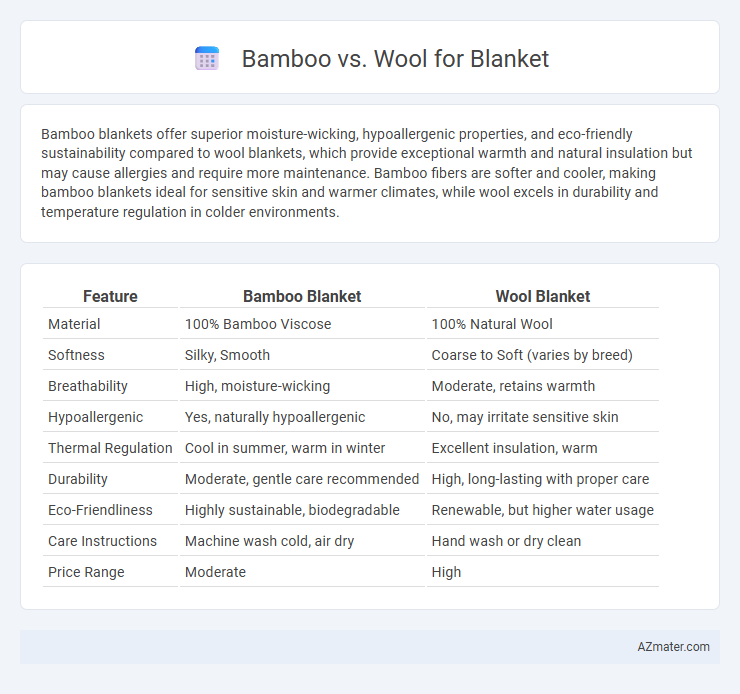Bamboo blankets offer superior moisture-wicking, hypoallergenic properties, and eco-friendly sustainability compared to wool blankets, which provide exceptional warmth and natural insulation but may cause allergies and require more maintenance. Bamboo fibers are softer and cooler, making bamboo blankets ideal for sensitive skin and warmer climates, while wool excels in durability and temperature regulation in colder environments.
Table of Comparison
| Feature | Bamboo Blanket | Wool Blanket |
|---|---|---|
| Material | 100% Bamboo Viscose | 100% Natural Wool |
| Softness | Silky, Smooth | Coarse to Soft (varies by breed) |
| Breathability | High, moisture-wicking | Moderate, retains warmth |
| Hypoallergenic | Yes, naturally hypoallergenic | No, may irritate sensitive skin |
| Thermal Regulation | Cool in summer, warm in winter | Excellent insulation, warm |
| Durability | Moderate, gentle care recommended | High, long-lasting with proper care |
| Eco-Friendliness | Highly sustainable, biodegradable | Renewable, but higher water usage |
| Care Instructions | Machine wash cold, air dry | Hand wash or dry clean |
| Price Range | Moderate | High |
Introduction to Bamboo and Wool Blankets
Bamboo blankets are crafted from bamboo fiber, known for its natural moisture-wicking, hypoallergenic, and breathable properties, making them ideal for sensitive skin and temperature regulation. Wool blankets, derived from sheep fleece, offer exceptional warmth, durability, and natural lanolin content that provides water resistance and insulation even when damp. Both materials present unique benefits, with bamboo emphasizing softness and cooling comfort, while wool focuses on warmth and resilience for cold environments.
Material Origins: Bamboo vs Wool
Bamboo blankets are made from fibers derived from the fast-growing bamboo plant, known for its sustainability and natural antibacterial properties. Wool blankets originate from the fleece of sheep, offering excellent insulation and moisture-wicking capabilities due to the lanolin content. Both materials provide unique thermal benefits, with bamboo excelling in breathability and wool in warmth retention.
Breathability and Temperature Regulation
Bamboo blankets excel in breathability due to their natural moisture-wicking properties, allowing air to circulate and keeping the sleeper cool and dry. Wool blankets provide superior temperature regulation by trapping heat without overheating, making them ideal for colder climates. Both materials offer breathable comfort, but bamboo is better suited for warm or humid environments, while wool excels in maintaining warmth during colder seasons.
Softness and Comfort Comparison
Bamboo blankets offer exceptional softness due to their naturally smooth fibers, making them ideal for sensitive skin and providing a silky, breathable comfort. Wool blankets provide warmth with a slightly coarser texture but excel in insulating properties and moisture-wicking capabilities, maintaining comfort in colder environments. Choosing between bamboo and wool depends on personal preference for tactile softness versus thermal insulation.
Hypoallergenic Properties
Bamboo blankets are highly hypoallergenic due to their natural antimicrobial and moisture-wicking properties, making them ideal for sensitive skin and allergy sufferers. Wool blankets, while breathable and moisture-regulating, can sometimes trigger allergic reactions or skin irritation in people sensitive to lanolin or animal fibers. Choosing bamboo ensures a softer, irritation-free experience with excellent resistance to dust mites and bacteria, essential for a hypoallergenic bedding environment.
Moisture-Wicking Abilities
Bamboo blankets excel in moisture-wicking due to their natural breathability and ability to absorb up to 40% more moisture than cotton, keeping sleepers dry and comfortable. Wool blankets also have strong moisture-wicking properties, absorbing up to 30% of their weight in moisture while maintaining warmth and preventing dampness. Both materials regulate temperature effectively, but bamboo's superior absorbency makes it ideal for hot sleepers or humid conditions.
Durability and Longevity
Bamboo blankets offer exceptional durability due to their natural fibers, which resist pilling and maintain softness after multiple washes. Wool blankets provide long-lasting strength and resilience, with their dense fibers offering excellent resistance to wear and tear over time. While bamboo excels in maintaining structural integrity, wool's natural elasticity ensures prolonged shape retention and warmth.
Eco-Friendliness and Sustainability
Bamboo blankets offer superior sustainability due to bamboo's rapid growth and minimal water requirements, making it an eco-friendly choice compared to wool, which relies on resource-intensive sheep farming. Wool production contributes to greenhouse gas emissions and land degradation, whereas bamboo cultivation absorbs more carbon dioxide and regenerates quickly without pesticides. Bamboo fibers are biodegradable and require less energy for processing, enhancing their appeal in sustainable textile manufacturing.
Care and Maintenance Requirements
Bamboo blankets require gentle machine washing with mild detergent and air drying to maintain softness and durability, while wool blankets need more careful hand washing or dry cleaning to prevent shrinking and felting. Wool fibers are more sensitive to heat and agitation, so using cold water and avoiding tumble drying is essential for wool blanket maintenance. Bamboo blankets generally offer easier care and quicker drying times, making them more convenient for everyday use compared to the more delicate care routine of wool blankets.
Cost and Value Analysis
Bamboo blankets typically cost less than wool blankets, offering a more budget-friendly option without sacrificing softness or breathability. Wool blankets provide superior insulation and durability, often justifying their higher price through long-term value and warmth retention. Consumers seeking affordable, lightweight comfort may prefer bamboo, while those valuing warmth and longevity tend to invest in wool despite the higher initial cost.

Infographic: Bamboo vs Wool for Blanket
 azmater.com
azmater.com